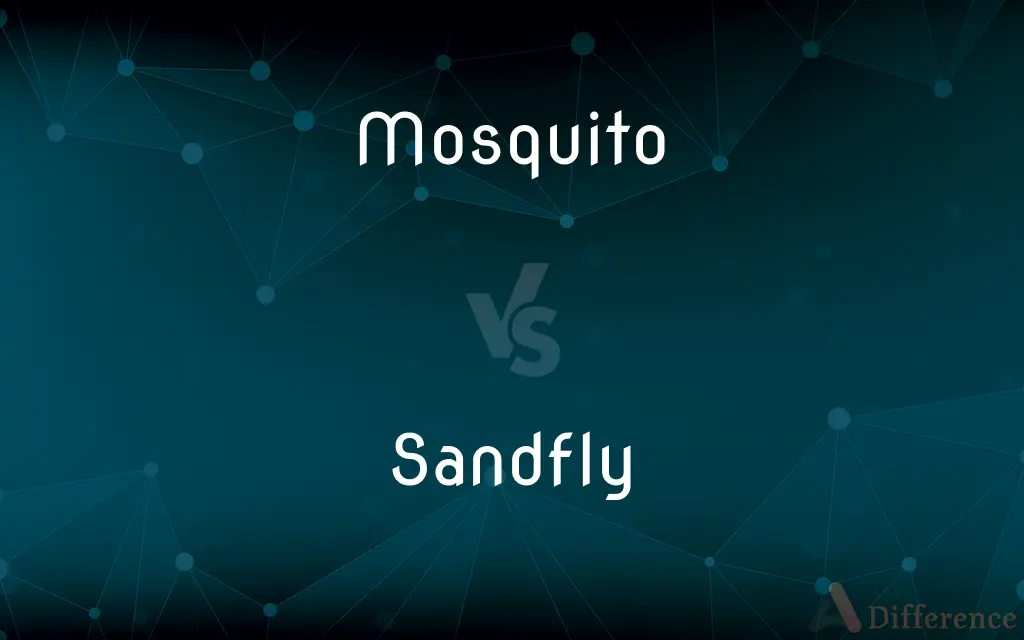Mosquito vs. Sandfly — What's the Difference?
Edited by Tayyaba Rehman — By Maham Liaqat — Updated on March 21, 2024
Mosquitoes are known for their ability to transmit diseases like malaria through their bites, which typically leave raised, itchy welt. Sandflies, smaller than mosquitoes, are notorious for their painful bites that can transmit diseases like leishmanias.

Difference Between Mosquito and Sandfly
Table of Contents
ADVERTISEMENT
Key Differences
Mosquitoes, belonging to the family Culicidae, are flying insects recognized for their role in spreading various diseases to humans and animals. In contrast, sandflies, which belong to the family Psychodidae, are much smaller insects known for their ability to transmit diseases like leishmaniasis. Sandfly bites are notoriously painful and can cause a red, blistering rash that takes longer to heal than mosquito bites.
Mosquitoes are found worldwide, with a significant presence in tropical and subtropical regions where conditions are humid and water is abundant for breeding. They are most active during dusk and dawn. Sandflies, however, prefer dry and sandy environments and are predominantly found in the tropics, subtropics, and some temperate regions. They typically become more active during the evening and night.
The lifecycle of a mosquito includes four stages: egg, larva, pupa, and growns, with water being a crucial element for their development. Sandflies also undergo a complete metamorphosis, but their larvae develop in moist soil rich in organic matter, indicating different environmental preferences for breeding.
Disease transmission is a significant concern with both insects. Mosquitoes are vectors for diseases such as malaria, dengue fever, Zika virus, and West Nile virus. Sandflies transmit leishmaniasis and a few other diseases, with leishmaniasis posing serious health problems in many parts of the world. The pathogens are spread through the bites of infected females in both species, who require meals to reproduce.
Prevention methods against mosquito and sandfly bites include using insect repellent, wearing long sleeves and pants, and employing bed nets. While both insects are vectors for disease, the diseases they spread and their methods of prevention and control may differ, reflecting the need for specific strategies tailored to each insect type.
ADVERTISEMENT
Comparison Chart
Size
Larger, visible wing beat.
Smaller, less noticeable.
Bite Appearance
Raised, itchy welt.
Red, blistering rash.
Active Period
Dusk and dawn.
Evening and night.
Breeding Environment
Stagnant or slow-moving water.
Moist soil with organic matter.
Diseases Transmitted
Malaria, dengue, Zika virus, West Nile virus.
Leishmaniasis, sandfly fever.
Geographic Distribution
Worldwide, prevalent in humid regions.
Tropics, subtropics, some temperate regions.
Prevention
Insect repellent, bed nets, removing standing water.
Insect repellent, protective clothing, fine mesh screens.
Compare with Definitions
Mosquito
Active primarily during dusk and dawn.
Mosquito activity peaks at twilight, increasing the risk of bites.
Sandfly
Bites can cause painful, blistering rashes.
Treating sandfly bites involves soothing the rash and preventing infection.
Mosquito
Bites result in itchy, raised welts.
After a mosquito bite, applying anti-itch cream can help soothe the skin.
Sandfly
Small insect transmitting leishmaniasis through bites.
Sandfly bites in certain tropical regions can lead to leishmaniasis.
Mosquito
Requires water for breeding.
Eliminating standing water can reduce mosquito populations.
Sandfly
Larvae develop in moist, organic-rich soil.
Sandflies breed in the organic matter found in forested areas.
Mosquito
Flying insect known for spreading diseases like malaria.
Mosquito nets are vital in preventing malaria in endemic regions.
Sandfly
Protection involves using fine mesh screens and repellent.
Fine mesh screens on windows can help keep sandflies out of homes.
Mosquito
Controlled through insect repellents and environmental management.
Community-wide efforts to control mosquitoes include spraying insecticides.
Sandfly
More active in the evening and at night.
Sandfly exposure increases during nighttime outdoor activities.
Mosquito
Mosquitoes are members of a group of about 3,500 species of small flies within the family Culicidae (from the Latin culex meaning "gnat"). The word "mosquito" (formed by mosca and diminutive -ito) is Spanish for "little fly".
Sandfly
Any of various small biting flies of the genus Phlebotomus of tropical areas, some of which transmit diseases.
Mosquito
See Miskito.
Sandfly
See biting midge.
Mosquito
To fly close to the ground, seemingly without a course.
Sandfly
(New Zealand) A small fly of the genus Austrosimulium.
Sandfly
(US) A biting midge (family Ceratopogonidae).
Common Curiosities
What are the primary diseases transmitted by mosquitoes and sandflies?
Mosquitoes transmit diseases like malaria and dengue fever, while sandflies are vectors for leishmaniasis and sandfly fever.
Can the spread of diseases by mosquitoes and sandflies be prevented?
Yes, using insect repellent, wearing protective clothing, employing bed nets, and environmental management strategies can significantly reduce the risk of bites and disease transmission.
What distinguishes mosquito bites from sandfly bites?
Mosquito bites typically result in raised, itchy welts, while sandfly bites can cause red, blistering rashes that may take longer to heal.
Are there vaccines available for diseases transmitted by these insects?
There are vaccines for some mosquito-borne diseases, like certain forms of encephalitis and yellow fever, but not for all. For diseases transmitted by sandflies, like leishmaniasis, vaccine development is ongoing, and prevention primarily relies on avoiding bites.
What times of day are you most at risk for mosquito and sandfly bites?
For mosquitoes, the highest risk period is during dusk and dawn when they are most active. Sandflies are more active in the evening and at night, increasing the risk of bites during these times.
Where are mosquitoes and sandflies found?
Mosquitoes are found worldwide, particularly in humid regions, while sandflies are more common in dry, sandy environments of the tropics, subtropics, and some temperate areas.
How effective are insect repellents in preventing mosquito and sandfly bites?
Insect repellents containing DEET, picaridin, or oil of lemon eucalyptus are effective against both mosquitoes and sandflies, significantly reducing the chances of getting bitten when used properly.
How do the breeding habits of mosquitoes and sandflies differ?
Mosquitoes breed in stagnant or slow-moving water, including ponds, marshes, and artificial containers, while sandflies breed in moist soil rich in organic matter, often in forests or rural areas.
Can mosquito and sandfly bites be treated the same way?
While basic treatment for insect bites—such as cleaning the area and applying anti-itch cream—applies to both, sandfly bites, which can cause more severe reactions, may require additional care to prevent infection and manage pain.
Why is control and prevention of mosquito and sandfly populations important?
Controlling these insect populations is crucial to prevent the spread of the diseases they carry, which can have significant health impacts on human populations, especially in endemic regions.
What environmental management strategies can help reduce mosquito and sandfly populations?
Removing standing water and maintaining clean yards can reduce mosquito breeding sites. For sandflies, reducing organic debris and altering landscaping to reduce moist, sandy soils can help limit their breeding grounds.
Share Your Discovery

Previous Comparison
Since vs. Sense
Next Comparison
Prednisone vs. MethylprednisoloneAuthor Spotlight
Written by
Maham LiaqatEdited by
Tayyaba RehmanTayyaba Rehman is a distinguished writer, currently serving as a primary contributor to askdifference.com. As a researcher in semantics and etymology, Tayyaba's passion for the complexity of languages and their distinctions has found a perfect home on the platform. Tayyaba delves into the intricacies of language, distinguishing between commonly confused words and phrases, thereby providing clarity for readers worldwide.
















































